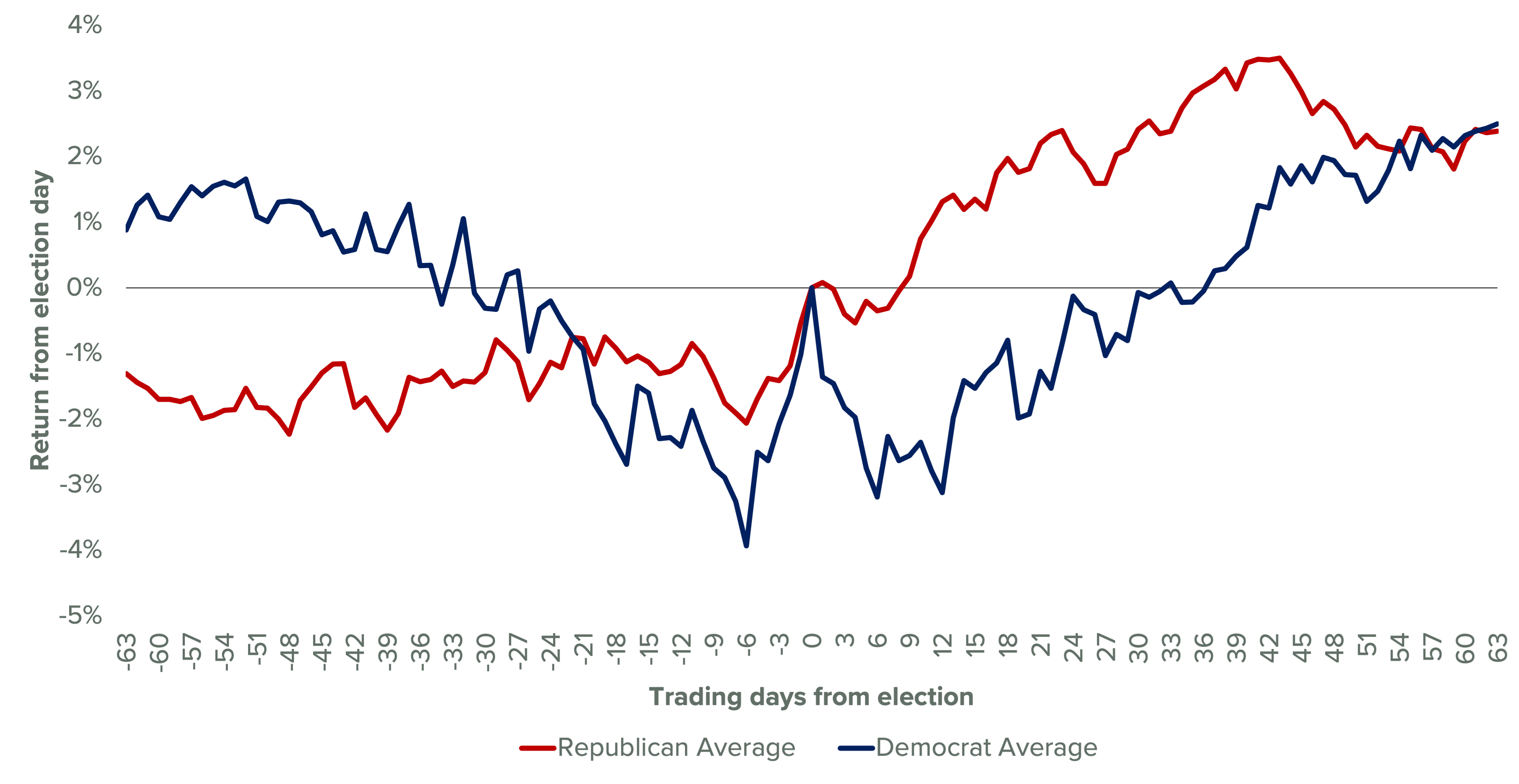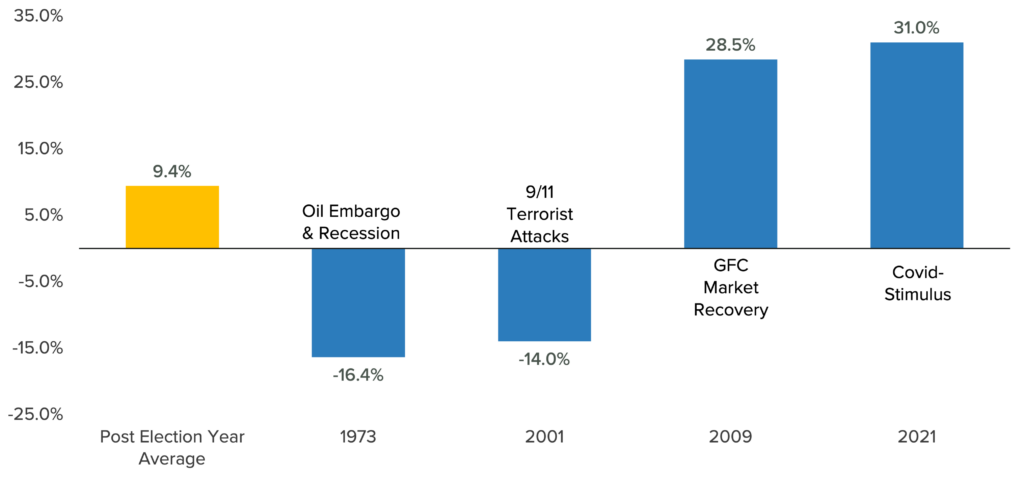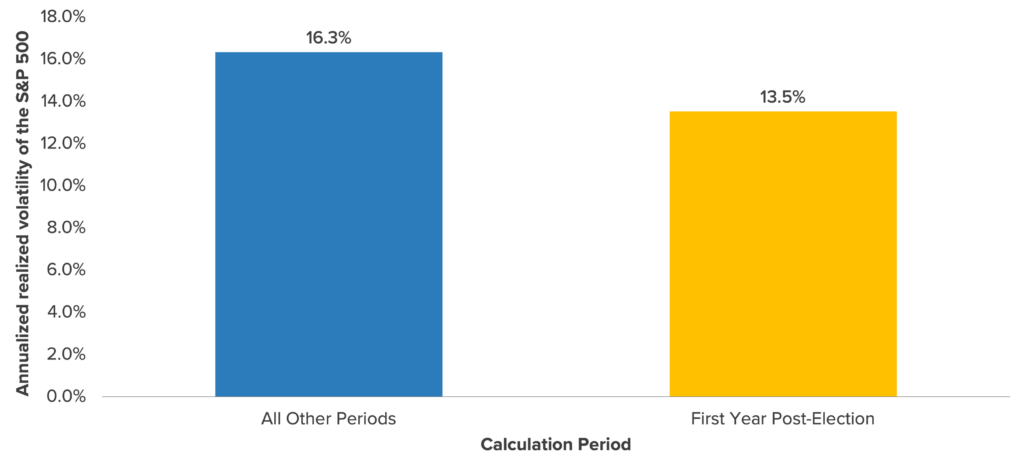Election Season: A Time for Ballots, Not Drastic Portfolio Changes
When major elections are near, investors may be concerned about how their portfolios will be impacted by the election’s outcome or what to do with their money if their preferred candidate loses.
Our view: Don’t let the political hype machine drive your investment decisions during the lead-up to an election. At Horizon Investments, we believe the smartest move going into the upcoming election is to stay committed to your goals-based investment plan.
The reason: Stocks have a habit of performing well whether there’s a Democrat or a Republican in the White House.
1. Three-month returns, post-election
Historically, the S&P 500’s performance has, on average, been positive three months after Presidential elections, regardless of the winner (see Chart 1). With Democratic victories, markets tend to fall slightly during the months prior to the election before rising post-election. In contrast, elections with Republican winners typically see markets rally into the election, with similar post-election gains. Either way, stocks have tended to gain ground post-election.
Chart 1: S&P 500 Returns Three Months Before and Three Months After an Election Since 1948

Source: Bloomberg, calculations by Horizon Investments, as of September 3, 2024. The S&P 500 is unmanaged and does not have fees or expense charges, both of which would lower returns. It is not possible to invest directly in an unmanaged index.
2. One-year returns, post-election
Likewise, investors have tended to enjoy strong returns during the first 12 months after each past election, with the S&P 500’s one-year return averaging 9.4% since 1948 (see Chart 2). Of course, there are often external factors that impact financial markets beyond just an election, as seen in the selected years below. As a result, one-year returns may be significantly higher or lower than the average.
Chart 2: S&P 500 Returns During the First 12 Months After an Election Since 1948

Source: Bloomberg, calculations by Horizon Investments, as of September 3, 2024. The S&P 500 is unmanaged and does not have fees or expense charges, both of which would lower returns. It is not possible to invest directly in an index.
3. One-year volatility, post-election
During the year after a Presidential election, stocks have actually been less volatile on average than they were during all other time periods (see Chart 3). In other words, equity investors have historically tended to experience relatively greater stability following an election–even if their preferred candidate didn’t win.
Chart 3: Realized Volatility During the First Year After an Election Since 1948

Source: Bloomberg, calculations by Horizon Investments, as of September 3, 2024. The S&P 500 is unmanaged and does not have fees or expense charges, both of which would lower returns. It is not possible to invest directly in an index.
Using history as an indicator, we think the lesson is clear: Whether there’s a donkey or an elephant in the Oval Office, staying invested is likely to be a solid strategy.
Understanding 2024: Candidate Perspectives on Economic & Financial Policies
While there are general conclusions we can draw about Presidential elections and their overall impact, each election cycle has distinct characteristics—and the upcoming 2024 race for the White House is no different. Two examples:
- The Democrat candidate, Vice President Kamala Harris, entered the race as the Presidential nominee a few weeks ago after President Joe Biden stepped down – a first-of-its-kind historical event.
- The Republican candidate, former President Donald Trump, was the target of an assassination attempt.
What’s most clear is that the Harris-Trump matchup is occurring during perhaps the most polarized political climate in modern history. Battle lines have largely been drawn not based on each candidate’s policies—many of which remain vague—but rather by party loyalty and ideology.
Still, it’s important to review available information about their respective positions and what that potentially means for the economy and the stock market. The caveat, of course, is that any such predictions are usually cloudy at best. Translating political platforms and promises into economy- and market-moving government policies is a notoriously difficult task.
That said, here’s our look at each candidate’s perspective and plans on key issues that may impact the broad economy and financial markets over the next four years.

These are each candidates’ stated positions as of September 10, 2024.
The policies in these categories certainly have the potential to impact the economy and influence market behavior. But the fact is, the long-term wealth creation power of financial markets is far more dependent on factors other than who controls the White House—as no one person, not even the President of the United States, wields enough power to reshape the economy single-handedly.
Indeed, in this election, control of Congress may be just as important (if not more so) than who wins the Presidency. A divided government would make legislation challenging to pass, likely leading to more unilateral actions by the executive branch. A Red or Blue sweep, on the other hand, may increase the opportunity for more extensive policy changes that would likely have a larger impact on markets.
The upshot: Don’t let candidates’ promises, or your emotional reactions to them, control your investment decisions. Vote with your ballot—not your portfolio.
Past performance is not indicative of future results. Any forecasts, figures, opinions or investment techniques and strategies set out are for informational purposes only, based on certain assumptions and current market conditions, and are subject to change without notice. All information presented herein is considered to be accurate as of the date of production, but the accuracy and completeness cannot be guaranteed. This material does not contain sufficient information to support an investment decision and it should not be relied upon for investing purposes. Investors should ensure that they obtain all available relevant information before making any investment. It should be noted that all investing involves risks, the value of investments and the income from them may fluctuate in accordance with market conditions and taxation agreements and investors may not get back the full amount invested. Both past performance and yield may not be a reliable guide to future performance.
The S&P 500 or Standard & Poor’s 500 Index is a market-capitalization-weighted index of the 500 largest U.S. publicly traded companies. References to indices, or other measures of relative market performance over a specified period of time are provided for informational purposes only. Reference to an index does not imply that any account will achieve returns, volatility or other results similar to that index. The composition of an index may not reflect the manner in which a portfolio is constructed in relation to expected or achieved returns, portfolio guidelines, restrictions, sectors, correlations, concentrations, volatility or tracking error targets, all of which are subject to change. It is not possible to invest directly in an index. Information obtained from third party sources is believed reliable but has not been vetted by the firm or its personnel.
Indices are unmanaged and do not have fees or expense charges, and dividend reinvestment makes no assumption about taxes, both of which would lower returns. It is not possible to invest directly in an unmanaged index.
Horizon Investments and the Horizon H are registered trademarks of Horizon Investments, LLC.
© 2024 Horizon Investments, LLC.


